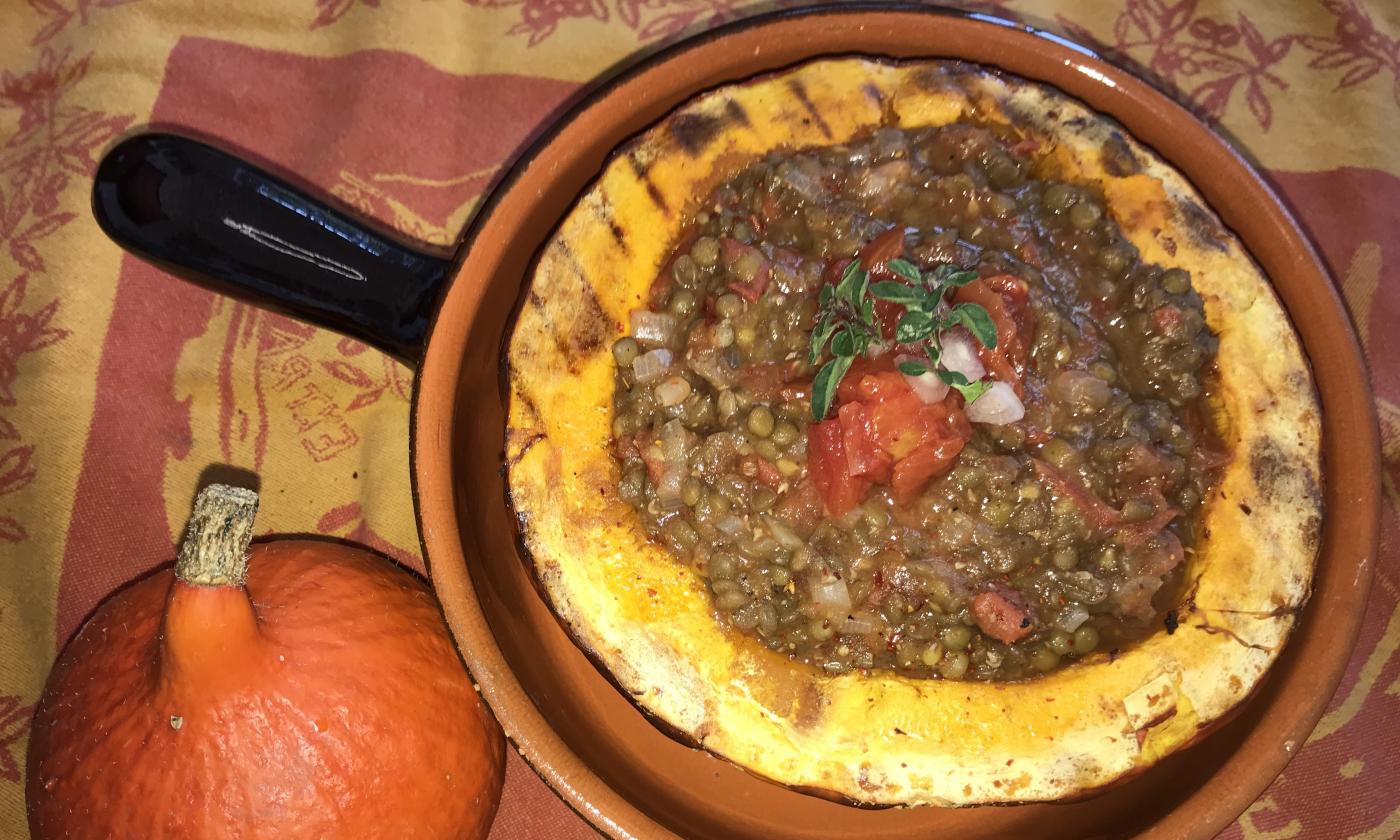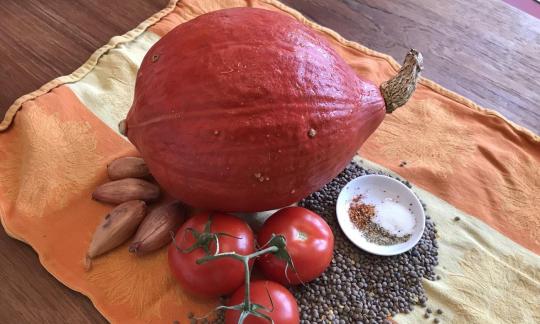Stuffed Hokkaido pumpkin with lentils and tomatoes
vegan
Ingredients (for servings, )
| Preparing Hokkaido pumpkin | |
|---|---|
| 1 kg | Hokkaido pumpkins (Hokkaido pumpkins) (35 oz) |
| For the filling | |
| 5 ¾ oz | Lentils (Erve, kitchen lentil), raw |
| 4 | Shallots, raw (organic?) (2.8 oz) |
| 3 | Tomatoes, raw (organic?) (13 oz) |
| 1 tsp, ground | Black pepper (organic?, raw?) (0.08 oz) |
| 1 dash | Table salt (table salt, raw?, organic?) (0.01 oz) |
| 1 ½ tsp | Chili flakes (raw?, organic?) (0.24 oz) |
Equipment
- skillet (frying pan) or saucepan
- stove
- oven
- pressure cooker
Type of preparation
- cook
- bake
- chop or grind
- sweat
- season to taste
- remove the skin
Preparation
Preparing the Hokkaido pumpkin
Wash the pumpkin well (as you can eat the skin) and cut it in half. Scrape out the seeds and fibers with a spoon and cut off the stalk so that the halves don't fall over. Bake the pumpkin (one large or two small halves) in the oven at 180°C on a rack lined with baking paper for around 20-30 minutes, depending on the size of the halves, until the pumpkin is cooked. Turn the halves halfway through the cooking time.1 kg of Hokkaido pumpkin corresponds approximately to a smaller or half a large Hokkaido pumpkin.
In the meantime, continue with steps 2 and 3.
Preparation of the filling
First, cook the lentils in a pressure cooker with about 3 times the amount of water for about 10-15 minutes. They should be soft, but not falling apart.We recommend using Pardina lentils, which do not require prior soaking and have a relatively short cooking time.
If you don't have a pressure cooker, you can also cook the lentils in a regular pot. This will extend the cooking time to about 30 minutes.Peel the shallots and cut into fine cubes. Wash the tomatoes and dice them finely. Put the shallots in a non-stick pan with a few diced tomatoes and the juice that comes out when cutting and sauté for about 3-5 minutes without oil. If it is too dry, add a few more diced tomatoes. Add the remaining tomatoes and sauté for another 3-5 minutes. Season to taste with pepper, salt and chili flakes.
We have not specified an amount for salt, as needs vary greatly. Try to keep the amount of salt as low as possible. More on this under "Tips".
Completing the dish
Remove the pumpkin halves from the oven and fill them with the filling. Arrange on a platter and serve immediately.
|
Nutritional Information per person
Convert per 100g
|
2000 kcal | |
|---|---|---|
| Energy | 545 kcal | 27.3% |
| Fat/Lipids | 2.2 g | 3.1% |
| Saturated Fats | 0.37 g | 1.8% |
| Carbohydrates (inc.dietary fiber) | 114 g | 42.1% |
| Sugars | 22 g | 24.6% |
| Fiber | 21 g | 85.4% |
| Protein/Albumin | 29 g | 57.6% |
| Cooking Salt (Na:119.9 mg) | 305 mg | 12.7% |
| Essential micronutrients with the highest proportions | per person | 2000 kcal | |
|---|---|---|---|
| Vit | Folate, as the active form of folic acid (née vitamin B9 and | 570 µg | 285.0% |
| Elem | Potassium, K | 2'975 mg | 149.0% |
| Prot | Tryptophan (Trp, W) | 0.32 g | 129.0% |
| Min | Manganese, Mn | 2.5 mg | 125.0% |
| Vit | Vitamin C (ascorbic acid) | 95 mg | 119.0% |
| Min | Copper, Cu | 1.2 mg | 116.0% |
| Prot | Threonine (Thr, T) | 1.1 g | 115.0% |
| Vit | Vitamin A, as RAE | 894 µg | 112.0% |
| Vit | Vitamin B6 (pyridoxine) | 1.6 mg | 111.0% |
| Prot | Isoleucine (Ile, I) | 1.3 g | 103.0% |
Detailed Nutritional Information per Person for this Recipe
The majority of the nutritional information comes from the USDA (US Department of Agriculture). This means that the information for natural products is often incomplete or only given within broader categories, whereas in most cases products made from these have more complete information displayed.
If we take flaxseed, for example, the important essential amino acid ALA (omega-3) is only included in an overarching category whereas for flaxseed oil ALA is listed specifically. In time, we will be able to change this, but it will require a lot of work. An “i” appears behind ingredients that have been adjusted and an explanation appears when you hover over this symbol.
For Erb Muesli, the original calculations resulted in 48 % of the daily requirement of ALA — but with the correction, we see that the muesli actually covers >100 % of the necessary recommendation for the omega-3 fatty acid ALA. Our goal is to eventually be able to compare the nutritional value of our recipes with those that are used in conventional western lifestyles.
| Essential fatty acids | per person | 2000 kcal |
|---|---|---|
| Alpha-Linolenic acid; ALA; 18:3 omega-3 | 0.28 g | 14.0% |
| Linoleic acid; LA; 18:2 omega-6 | 0.73 g | 7.0% |
| Essential amino acids | per person | 2000 kcal |
|---|---|---|
| Tryptophan (Trp, W) | 0.32 g | 129.0% |
| Threonine (Thr, T) | 1.1 g | 115.0% |
| Isoleucine (Ile, I) | 1.3 g | 103.0% |
| Lysine (Lys, K) | 1.8 g | 99.0% |
| Phenylalanine (Phe, F) | 1.4 g | 91.0% |
| Valine (Val, V) | 1.4 g | 90.0% |
| Leucine (Leu, L) | 2.1 g | 85.0% |
| Methionine (Met, M) | 0.30 g | 32.0% |
| Vitamins | per person | 2000 kcal |
|---|---|---|
| Folate, as the active form of folic acid (née vitamin B9 and | 570 µg | 285.0% |
| Vitamin C (ascorbic acid) | 95 mg | 119.0% |
| Vitamin A, as RAE | 894 µg | 112.0% |
| Vitamin B6 (pyridoxine) | 1.6 mg | 111.0% |
| Thiamine (vitamin B1) | 0.99 mg | 90.0% |
| Pantothenic acid (vitamin B5) | 3.1 mg | 51.0% |
| Riboflavin (vitamin B2) | 0.58 mg | 41.0% |
| Vitamin K | 30 µg | 40.0% |
| Niacin (née vitamin B3) | 6.2 mg | 39.0% |
| Biotin (ex vitamin B7, H) | 15 µg | 30.0% |
| Vitamin E, as a-TEs | 2.1 mg | 18.0% |
| Essential macroelements (macronutrients) | per person | 2000 kcal |
|---|---|---|
| Potassium, K | 2'975 mg | 149.0% |
| Phosphorus, P | 429 mg | 61.0% |
| Magnesium, Mg | 144 mg | 38.0% |
| Calcium, Ca | 210 mg | 26.0% |
| Sodium, Na | 120 mg | 15.0% |
| Essential trace elements (micronutrients) | per person | 2000 kcal |
|---|---|---|
| Manganese, Mn | 2.5 mg | 125.0% |
| Copper, Cu | 1.2 mg | 116.0% |
| Iron, Fe | 9.7 mg | 69.0% |
| Zinc, Zn | 4.4 mg | 44.0% |
| Selenium, Se | 2.7 µg | 5.0% |
| Iod, I (Jod, J) | 2.6 µg | 2.0% |
| Fluorine, F | 4.6 µg | < 0.1% |
The oil-free stuffed Hokkaido pumpkin with lentils and tomatoes is easy to make and healthy.
Serving size: We have designed the recipe for 2 large main courses without any additional side dishes. If you serve it with a salad, for example, it is enough for 3 portions.
Nutrient profile: According to GDA guidelines, one portion of this dish covers almost three times the average daily requirement of folic acid. It also covers over 100% of the daily requirement of the trace elements potassium, copper and manganese and the essential amino acids tryptophan, threonine and isoleucine as well as vitamins C and B6. The ratio of omega-6 to omega-3 fatty acids is 3:1, which is below the recommended maximum ratio of 5:1. You can find further information at the following link: Vegans often eat unhealthily. Avoidable nutritional errors.
Hokkaido pumpkin: Unlike most other pumpkins, the skin of the Hokkaido pumpkin, which only weighs 1-2 kg, is eaten as it becomes soft when cooked. The flesh has a stable consistency, is low in fiber and has a slightly nutty flavor. It owes its orange color to the high amount of beta-carotene it contains, which our body can convert into vitamin A.
Lentils: Because of their high-quality proteins, lentils are a very good source of plant-based protein for vegans. You should be aware, however, that they only contain a relatively small amount of the essential amino acid methionine, for example, which is why combining them with rice or beans can compensate for this in some dishes. The different types of lentils, which are uniformly round and flat, differ in size and color. The Pardina lentil, which we use in this dish, has a gray-brown shell and a yellow interior. It has been cultivated in northern Spain for more than 800 years. Here, this type of lentil is also known as brown lentil. It is often confused with plate lentils, which look similar but are larger. Pardina lentils do not need to be soaked beforehand. The cooking time is 30 minutes. This can be reduced to 10-15 minutes by using a pressure cooker.
Reduce salt and oil: For health reasons, we have deliberately not used any oil in the preparation and have not specified any amount of salt, as the need for salt varies greatly depending on habits. Basically, you should keep the salt content as low as possible. You can find more information on this topic in the book we describe in detail: "Salt Sugar Fat" by Michael Moss.
Pre-cook lentils: You can pre-cook lentils and store them in the refrigerator for about 4 days.






